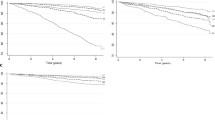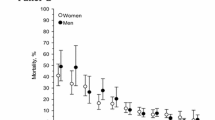Abstract
Purpose
We examined whether changes in health-related quality of life (HRQL) predict subsequent mortality among the Spanish elderly.
Methods
Prospective cohort study of 2,373 persons, representative of the Spanish population aged 60 and older. HRQL was measured in 2001 and 2003 using the SF-36 health questionnaire. Cox regression models were used to examine the association of changes in the physical and mental component summary (PCS and MCS) scores of HRQL from 2001 to 2003 with all-cause mortality through 2007.
Results
Two hundred twelve deaths were ascertained from 2003 to 2007. The hazard ratios for mortality across categories of PCS change were as follows: 2.12 (95% confidence interval [CI] 1.39–3.24) for a > 10-point decline; 1.51 (1.01–2.28) for a 6- to 10-point decline; 1 for the reference category, a change of −5 to +5 points; 0.83 (0.51–1.34) for a 6- to 9-point improvement and 0.68 (0.42–1.09) for a > 10-point improvement; P for linear trend <0.001. The associations between changes in the MCS and mortality showed the same direction, but were of a lower magnitude and attained statistical significance (P < 0.05) only for a > 10-point decline in MCS.
Conclusions
Changes in HRQL predict mortality in the older adults. A decline in HRQL should alert to a worse vital prognosis and stimulate the search for the possible determinants of such decline.
Similar content being viewed by others
Abbreviations
- HRQL:
-
Health-related quality of life
- PCS:
-
Physical component summary (of SF-36)
- MCS:
-
Mental component summary (of SF-36)
- HRs:
-
Hazard ratios
- CI:
-
Confidence interval
- NHS:
-
Nurses’ Health Study
- BMI:
-
Body mass index
- LRTs:
-
Likelihood ratio tests
References
Hickey, A., Barker, M., McGee, H., & O’Boyle, C. (2005). Measuring health-related quality of life in older patient populations: A review of current approaches. Pharmacoeconomics, 23(10), 971–993 [Review].
Testa, M. A., & Simonson, D. C. (1996). Assesment of quality-of-life outcomes. New England Journal of Medicine, 334(13), 835–840.
Rumsfeld, J. S., MaWhinney, S., McCarthy, M., Jr., Shroyer, A. L., VillaNueva, C. B., O’Brien, M., et al. (1999). Health-related quality of life as a predictor of mortality following coronary artery bypass graft surgery. Participants of the department of veterans affairs cooperative study group on processes, structures, and outcomes of care in cardiac surgery. JAMA, 281(14), 1298–1303.
Rodriguez-Artalejo, F., Guallar-Castillon, P., Pascual, C. R., Otero, C. M., Montes, A. O., Garcia, A. N., et al. (2005). Health-related quality of life as a predictor of hospital readmission and death among patients with heart failure. Archives of Internal Medicine, 165(11), 1274–1279.
Domingo-Salvany, A., Lamarca, R., Ferrer, M., Garcia-Aymerich, J., Alonso, J., Felez, M., et al. (2002). Health-related quality of life and mortality in male patients with chronic obstructive pulmonary disease. American Journal of Respiratory and Critical Care Medicine, 166(5), 680–685.
Singh, J. A., Nelson, D. B., Fink, H. A., & Nichol, K. L. (2005). Health-related quality of life predicts future health care utilization and mortality in veterans with self-reported physician-diagnosed arthritis: The veterans arthritis quality of life study. Seminars in Arthritis and Rheumatism, 34(5), 755–765.
Fan, V. S., Au, D. H., McDonell, M. B., & Fihn, S. D. (2004). Intraindividual change in SF-36 in ambulatory clinic primary care patients predicted mortality and hospitalizations. Journal of Clinical Epidemiology, 57(3), 277–283.
Lee, Y. (2000). The predictive value of self assessed general, physical, and mental health on functional decline and mortality in older adults. Journal of Epidemiology and Community Health, 54(2), 123–129.
Tsai, S. Y., Chi, L. Y., Lee, C. H., & Chou, P. (2007). Health-related quality of life as a predictor of mortality among community-dwelling older persons. European Journal of Epidemiology, 22(1), 19–26.
Kaplan, M. S., Berthelot, J. M., Feeny, D., McFarland, B. H., Khan, S., & Orpana, H. (2007). The predictive validity of health-related quality of life measures: Mortality in a longitudinal population-based study. Quality of Life Research, 16(9), 1539–1546.
Myint, P. K., Luben, R. N., Surtees, P. G., Wainwright, N. W., Welch, A. A., Bingham, S. A., et al. (2006). Relation between self-reported physical functional health and chronic disease mortality in men and women in the European prospective investigation into cancer (EPIC-Norfolk): A prospective population study. Annals of Epidemiology, 16(6), 492–500.
Zahran, H. S., Kobau, R., Moriarty, D. G., Zack, M. M., Holt, J., & Donehoo, R. (2005). Health-related quality of life surveillance—United States, 1993–2002. MMWR Surveillance Summaries, 54(4), 1–35.
Knight, E. L., Ofsthun, N., Teng, M., Lazarus, J. M., & Curhan, G. C. (2003). The association between mental health, physical function, and hemodialysis mortality. Kidney International, 63(5), 1843–1851.
Kroenke, C. H., Kubzansky, L. D., Adler, N., & Kawachi, I. (2008). Prospective change in health-related quality of life and subsequent mortality among middle-aged and older women. American Journal of Public Health, 98(11), 2085–2091.
Leon-Munoz, L. M., Guallar-Castillon, P., Banegas, J. R., Gutierrez-Fisac, J. L., Lopez-Garcia, E., Jimenez, F. J., et al. (2005). Changes in body weight and health-related quality-of-life in the older adult population. International Journal of Obesity (London), 29(11), 1385–1391.
Lopez-Garcia, E., Banegas, J. R., Graciani, A., Gutierrez-Fisac, J. L., Alonso, J., & Rodriguez-Artalejo, F. (2003). Population-based reference values for the Spanish version of the SF-36 health survey in the elderly. Medicina Clínica (Barcelona), 120(15), 568–573.
Galan, I., Rodriguez-Artalejo, F., & Zorilla, B. (2004). Reproducibility of a telephone questionnaire on risk factors associated with behavior and preventive practices. Gaceta Sanitaria, 18(2), 118–128.
Galan, I., Rodriguez-Artalejo, F., & Zorrilla, B. (2004). Telephone versus face-to-face household interviews in the assessment of health behaviors and preventive practices. Gaceta Sanitaria, 18(6), 440–450.
Nelson, D. E., Holtzman, D., Bolen, J., Stanwyck, C. A., & Mack, K. A. (2001). Reliability and validity of measures from the behavioral risk factor surveillance system (BRFSS). Sozial- und Praventivmedizin, 46(Suppl 1), S3–S42.
Nelson, D. E., Powell-Griner, E., Town, M., & Kovar, M. G. (2003). A comparison of national estimates from the national health interview survey and the behavioral risk factor surveillance system. American Journal of Public Health, 93(8), 1335–1341.
Navarro, C. (2006). The national death index: A largely expected advance in the access to mortality data. Gaceta Sanitaria, 20(6), 421–423.
Alonso, J. (2000). Manual de puntuación de la versión española del cuestionario de salud SF-36. Institut municipal d’ Investigació Médica (IMIM) ed. Barcelona.
Alonso, J., Regidor, E., Barrio, G., Prieto, L., Rodríguez, C., & de la, F. L. (1998). Population reference values of the Spanish version of the health questionnaire SF-36. Medicina Clínica (Barcelona), 111(11), 410–416.
Ferrer, M., & Alonso, J. (1998). The use of the short form (SF)-36 questionnaire for older adults. Age and Ageing, 27(6), 755–756.
Alonso, J., Prieto, L., & Anto, J. M. (1995). The Spanish version of the SF-36 health survey (the SF-36 health questionnaire): An instrument for measuring clinical results. Medicina Clínica (Barcelona), 104(20), 771–776.
Garcia, M., Rohlfs, I., Vila, J., Sala, J., Pena, A., Masia, R., et al. (2005). Comparison between telephone and self-administration of short form health survey questionnaire (SF-36). Gaceta Sanitaria, 19(6), 433–439.
Garcia, E. L., Banegas, J. R., Perez-Regadera, A. G., Cabrera, R. H., & Rodriguez-Artalejo, F. (2005). Social network and health-related quality of life in older adults: A population-based study in Spain. Quality of Life Research, 14(2), 511–520.
Guallar-Castillon, P., Santa-Olalla, P. P., Banegas, J. R., Lopez, E., & Rodriguez-Artalejo, F. (2004). Physical activity and quality of life in older adults in Spain. Medicina Clínica (Barcelona), 123(16), 606–610.
Guallar-Castillon, P., Sendino, A. R., Banegas, J. R., Lopez-Garcia, E., & Rodriguez-Artalejo, F. (2005). Differences in quality of life between women and men in the older population of Spain. Social Science and Medicine, 60(6), 1229–1240.
Lopez-Garcia, E., Banegas, B., Jr., Gutierrez-Fisac, J. L., Perez-Regadera, A. G., Ganan, L. D., & Rodriguez-Artalejo, F. (2003). Relation between body weight and health-related quality of life among the elderly in Spain. International Journal of Obesity and Related Metabolic Disorders, 27(6), 701–709.
Gutierrez-Fisac, J. L., Lopez, E., Banegas, J. R., Graciani, A., & Rodriguez-Artalejo, F. (2004). Prevalence of overweight and obesity in elderly people in Spain. Obesity Research, 12(4), 710–715.
Bush, T. L., Miller, S. R., Golden, A. L., & Hale, W. E. (1989). Self-report and medical record report agreement of selected medical conditions in the elderly. American Journal of Public Health, 79(11), 1554–1556.
Harlow, S. D., & Linet, M. S. (1989). Agreement between questionnaire data and medical records. The evidence for accuracy of recall. American Journal of Epidemiology, 129(2), 233–248.
Ware, J. E., Snow, K. K., Kosinski, M., & Gandek, B. (1993). SF-36 Health survey. Manual and interpretation guide. The Health Institute, New England Medical Center ed. Boston.
Vilagut, G., Ferrer, M., Rajmil, L., Rebollo, P., Permanyer-Miralda, G., Quintana, J. M., et al. (2005). The Spanish version of the short form 36 health survey: A decade of experience and new developments. Gaceta Sanitaria, 19(2), 135–150.
Cain, K. C., Kronmal, R. A., & Kosinski, A. S. (1992). Analysing the relationship between change in a risk factor and risk of disease. Statistics in Medicine, 11(6), 783–797.
Cary, N. C. (2001). SAS/STAT Guide for personal computers version 8.2.
Alonso, J., Ferrer, M., Gandek, B., Ware, J. E., Jr., Aaronson, N. K., Mosconi, P., et al. (2004). Health-related quality of life associated with chronic conditions in eight countries: Results from the international quality of life assessment (IQOLA) project. Quality of Life Research, 13(2), 283–298.
Cunningham, W. E., Nakazono, T. T., Tsai, K. L., & Hays, R. D. (2003). Do differences in methods for constructing SF-36 physical and mental health summary measures change their associations with chronic medical conditions and utilization? Quality of Life Research, 12(8), 1029–1035.
Acknowledgments
This study was partly funded by FIS grant 06/0366.
Author information
Authors and Affiliations
Corresponding author
Rights and permissions
About this article
Cite this article
Otero-Rodríguez, A., León-Muñoz, L.M., Balboa-Castillo, T. et al. Change in health-related quality of life as a predictor of mortality in the older adults. Qual Life Res 19, 15–23 (2010). https://doi.org/10.1007/s11136-009-9561-4
Accepted:
Published:
Issue Date:
DOI: https://doi.org/10.1007/s11136-009-9561-4




